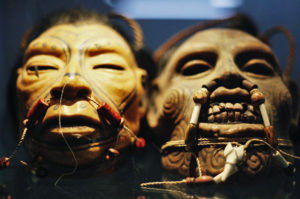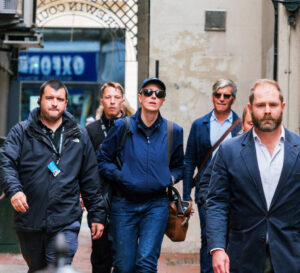The last weeks of Charles Byrne’s life were nightmarish. Known as the Irish Giant, the seven-foot seven-inch man from Ulster had made his way in 1782 to London, where he earned money by exhibiting himself as a freak. By the end of that year tragedy was overtaking him. He was addicted to alcohol and suffered from the painful effects of a pituitary tumour in his brain, the cause of his gigantism. The accrued savings of his 22 years of life — around £700 — had been stolen in a Haymarket pub.
Even in this condition, Byrne was allowed no dignity. The city’s anatomy schools were eager to dissect his body as a scientific prize. Among these circling vultures, none was more determined than the aptly named John Hunter, eminent surgeon, anatomist, and collector of organic specimens both animal and human.
A horrified Byrne had already rejected Hunter’s offer to buy his corpse and, in a final, desperate bid to escape the surgeon’s saws, asked his friends to encase his body in lead and sink it in the English Channel after he died. But Hunter managed to pay for the cadaver to be secretly removed from its coffin and transported to his home in Earl’s Court. There he boiled it down to its bones and reassembled it as a skeleton. “I lately got a tall man,” he hinted to a friend some years after.
The surgeon’s vast collection of pickled creatures and body parts would later become the nucleus of London’s Hunterian Museum. But last month, when the Hunterian reopened after a lengthy closure, the Irish Giant had been tactfully removed from display. After almost 250 years, John Hunter’s flouting of a dying man’s wishes is catching up with him.
There are, of course, many museums that display the remnants of people wrenched from their graves — or of those never allowed to lie down in them. Stories such as Byrne’s raise uncomfortable questions about this practice. When, if ever, do human remains cease to be human? Does the sanctity of death end at the borders of our own culture and era?
These issues have arisen before. Thirty years ago, the South African government demanded the return of Sara Baartman, a Khoisan woman who in the early-19th century was paraded around Europe, only to be dissected after her death and displayed in a Paris museum until the Seventies. But the morality of displaying human remains has become more broadly contentious in recent years.
In 2020, Oxford’s Pitt Rivers museum removed all of its human exhibits, including shrunken heads from Amazonia’s Shuar tribe, claiming that “visitors often understood the Museum’s displays of human remains as a testament to other cultures being ‘savage,’ ‘primitive’ or ‘gruesome,’” which “reinforced racist stereotypes”. Numerous British and American museums have changed their method of displaying Egyptian mummies, an enormous crowd-pleaser, using terms such as “mummified person” in an effort to humanise the objects.
It is striking, then, how proudly the Hunterian Museum now reveals its gruesome contents to the public. It seems Charles Byrne was omitted because, like Sara Baartman, he is a high-profile case, subject to ongoing controversy after the British Medical Journal covered it in 2011. But the museum is still packed with human remains, presented no differently from the countless animal specimens floating eerily in their glass jars. There is row upon row of skulls gathered from numerous continents, pickled brains, warped spines, infant skeletons, cabinets of teeth, all manner of internal organs, and foetuses ranging from nine weeks to full term. It is a truly ghoulish spectacle.
Hunter claimed to have “dissected some thousands” of human corpses. A small number did consent; the Georgian upper classes were warming to the idea of donating their bodies for scientific enquiry. An Archbishop of Canterbury, several military leaders and a serving prime minister (the Marquess of Rockingham) were among those who volunteered for Hunter’s knife.
But the vast majority who ended up in 18th-century anatomy theatres had no say in the matter. Some were wrestled away from their families beneath Tyburn Tree, the gallows in Hyde Park where dozens of criminals were hanged every year. Others were acquired through the bribing of undertakers. Most commonly though, they were stolen from their graves by gangs of professional body snatchers. Hunter himself almost certainly robbed graves in his youth, when he spent 12 years learning the ropes at his brother’s anatomy school.
The grim provenance of Hunter’s collection is addressed only in a brief wall text at the museum. Acknowledging the specimens were gathered “before modern standards of consent”, it states: “We recognise the debt owed to those people… who in life and death have helped to advance medical knowledge.” Why, then, has the display of Egyptian mummies come to be regarded as a sensitive problem, but less so the display of an unborn child probably removed from the womb of a stolen corpse?
One reason is simply that the humanity of the dead only becomes an issue when someone makes it an issue. The controversy over mummies, for instance, reflects a particular convergence of political beliefs: some modern Egyptians, not to mention the modern Egyptian state, are now identifying as descendants of the ancient civilisation on the Nile. At the same time, Western curators have become desperate to distance themselves from the colonial period during which these objects were acquired. By contrast, there are few people in Britain who feel so strongly about scores of impoverished Londoners pulled from their shallow graves in the dead of night.
But there is another important difference. The claim that Hunter’s activities “have helped to advance medical knowledge” is a powerful one, linking his specimens with the achievements of modern medicine. It is also clearly true. Without a legal way to acquire bodies — and with religious beliefs making voluntary dissection unthinkable to many — only stolen corpses could produce the beginnings of the anatomical knowledge that we take for granted today. The museum subtly emphasises this by charting the development of surgery from the early-modern period to our own time: rather dull after the horror show of Hunter’s collection, but that’s the point I suppose.
Charles Byrne’s skeleton might be too controversial to display, but the museum has insisted on keeping it due to its medical value. It helped an American neurosurgeon to identify pituitary gigantism in 1909, and a century later, allowed scientists to find a genetic component in the growth disorder.
What all of this points to is the special status of medical science in Western countries today. Museums and other cultural institutions are increasingly critical of the heritage they embody because, ultimately, they no longer believe it has served a positive purpose that could mitigate the brutality of the past. This goes far beyond the problem of human remains; as Guardian critic Jonathan Jones notes about Tate Britain’s recent guilt-laden rehang: “Maybe it doesn’t want to promote British art, for it seems to disapprove of much of it.” Yet there are not many people arguing that we should abandon the benefits of modern medicine since it, too, has a disturbing history. This is one area where progress is still understood as building on the past rather than overturning it: the only acceptable agenda for healthcare is more and better.
But Hunter’s collection also reveals a deep tension in the way we value medical science. If we consider it dehumanising to display body parts in jars, it is partly because we now struggle to recognise blood and tissue as human. Our technical mastery over biology has led to our alienation from it. Just as we expect our meat to arrive immaculately packaged in the supermarket, carrying no trace of the abattoir, so we banish birth, illness, and death from our everyday lives, consigning them to the clinical world of the hospital. We have never been more preoccupied with the condition of our bodies, yet we don’t like to see those bodies for what they really are.
Disclaimer
Some of the posts we share are controversial and we do not necessarily agree with them in the whole extend. Sometimes we agree with the content or part of it but we do not agree with the narration or language. Nevertheless we find them somehow interesting, valuable and/or informative or we share them, because we strongly believe in freedom of speech, free press and journalism. We strongly encourage you to have a critical approach to all the content, do your own research and analysis to build your own opinion.
We would be glad to have your feedback.
Source: UnHerd Read the original article here: https://unherd.com/




